Keeping you abreast!
Okay folks,
I know how we like photos, and I had taken a bunch several years ago when I first installed this new battery, to make a tech tip about what to do when you install a new battery, etc., but never got around to posting them.
Okay, just showing the packaging for the Walmart brand, that it comes with the battery and acid packed separately, it's "dry charged", and you get to add the acid once you get it home.
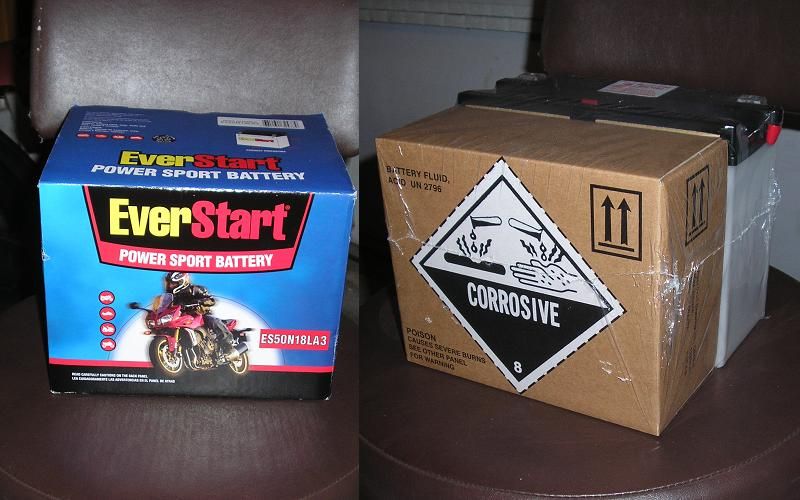
Just a warning about removing the drain hose port cover so that it can vent when you add the acid as well as charging later.
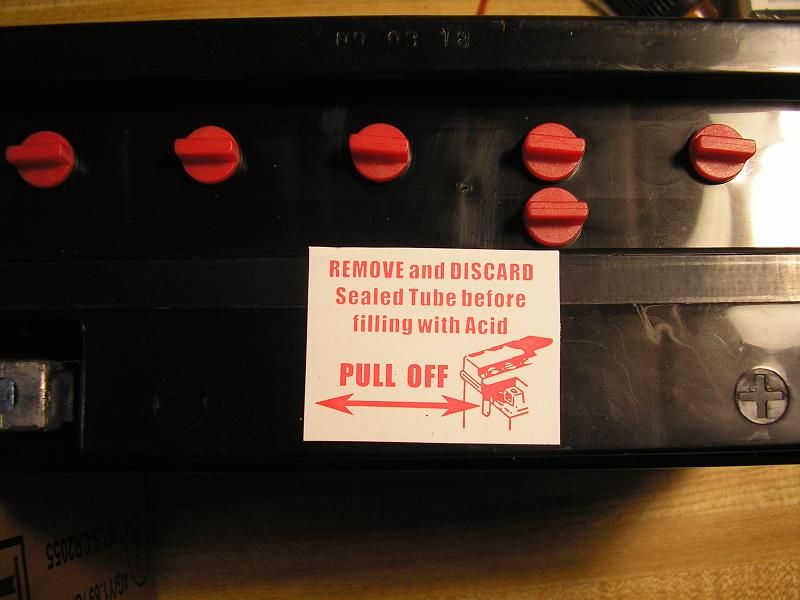
Showing a backlit view so you can see the dry cells, and the low and high water indicator lines.
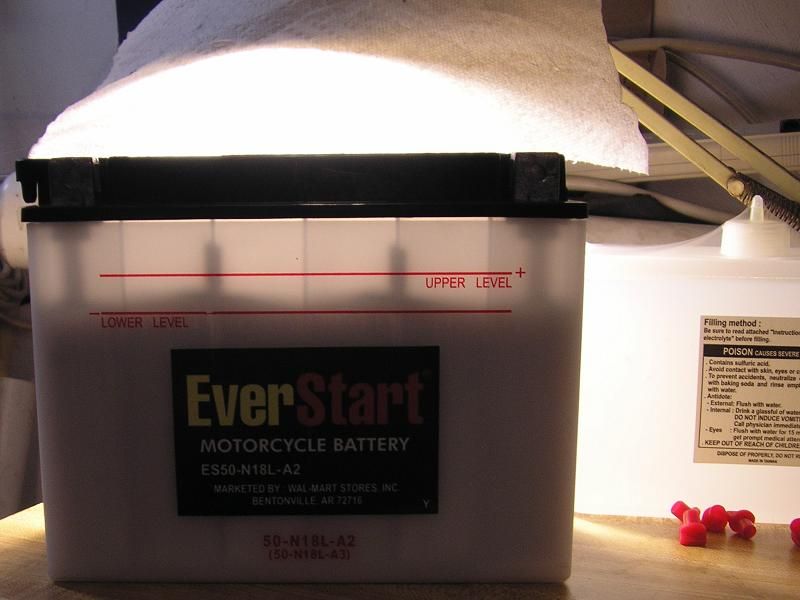
Here I am adding the electrolyte, it comes with a handy little hose, I should have been wearing gloves! Having the backlit helps to visualize the fluid levels without having to stick your face/eyes directly OVER the battery filler holes, fumes and such!
Having the backlit helps to visualize the fluid levels without having to stick your face/eyes directly OVER the battery filler holes, fumes and such!
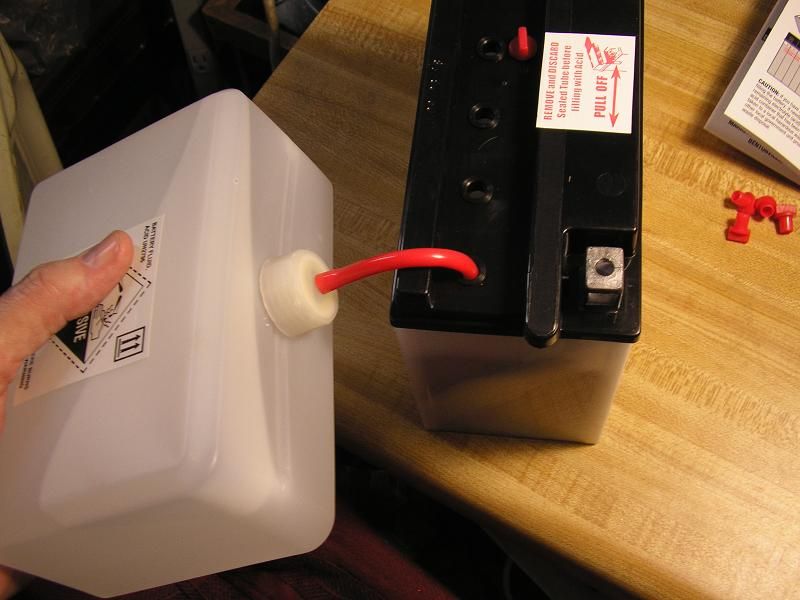
Next just shows the barely 12 volts reading on the voltmeter after putting in the electrolyte.
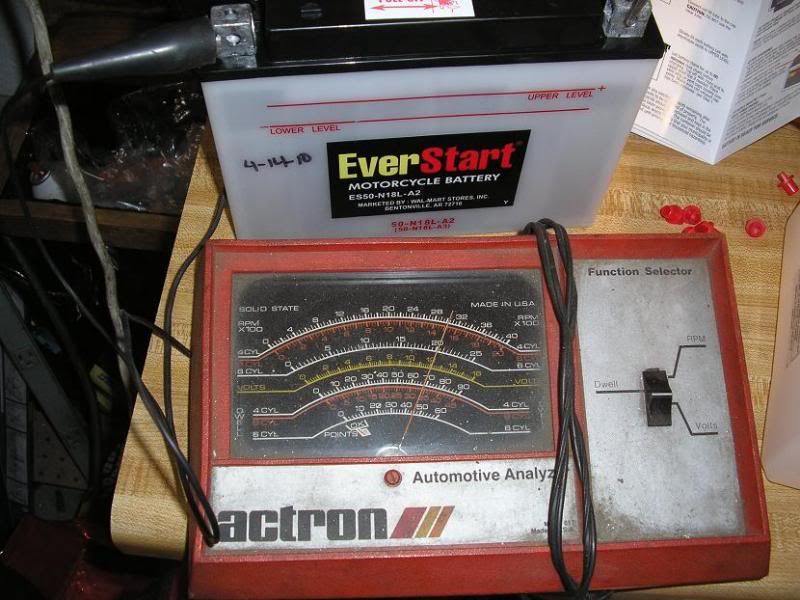
These show it first being on the 2 amp charger...and then after it's been on for some 10 or so hours after it's reached it's full charge potential. IT's highly recommended to do this BEFORE you ever put the battery into service.
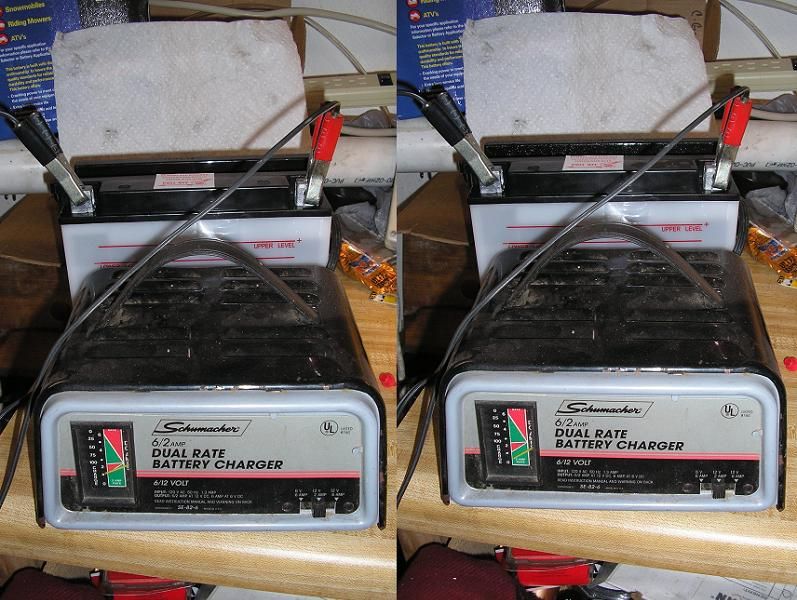
And the final voltmeter reading showing a good 13 volts after the charge.
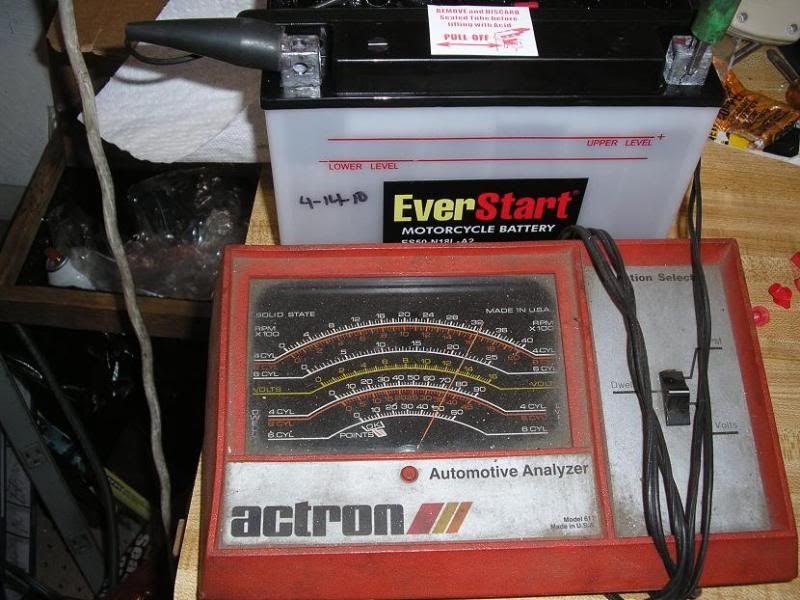
Now the same battery some 3+ years later, after it sat in the garage for 2 months and allowed to go totally FLAT, and apparently it also ran low on water. I had filled it up just prior to going on the Rally Ride in Sept.! Some of you will also remember that I'm using the Mini-Race Alternator, it does put out a lot more power than the OEM REG/RECT/ALT combo, but I've got a voltmeter on it, and it doesn't go above 14 or so volts while riding, so I don't think it's getting OVERCHARGED while riding, just that the air has been quite dry around here, and it's just slowly evaporated over the last 2 months that it's been sitting....it's NOT been on a trickle/float charger!
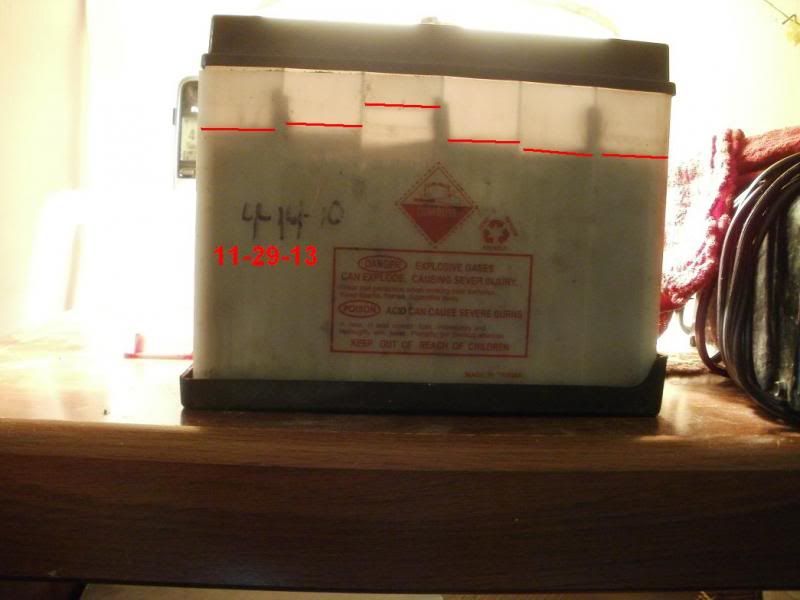
A couple of days prior to this, I had mentioned that I had tried to charge it with the same shown charger, first on 2 amps for a day, and then on 6 amps overnight! Then just let it sit for a day or so until I got new fancy Pulse charger...and so the voltmeter shows not quite 5 volts!

Put it on the same charger in the 6 amp mode for about an hour.
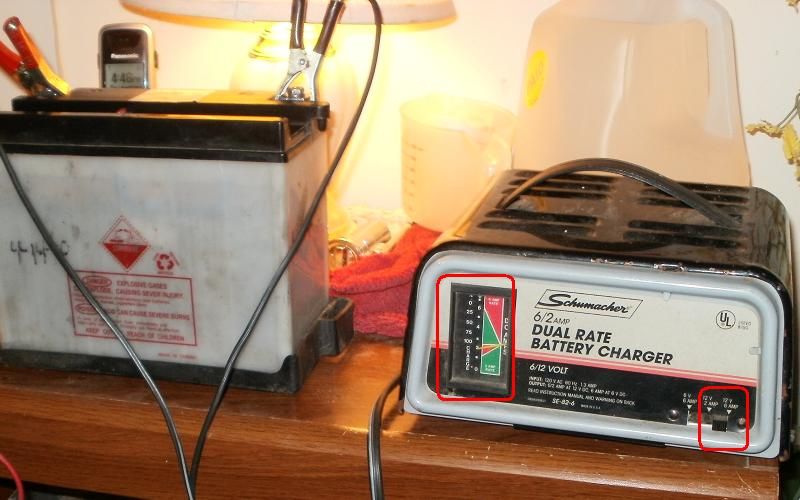
And then the voltmeter shows it got up to almost 12 volts....needed to get it up to 10.5 or more before being able to hook up the fancy PULSE charger..needs the 10.5 minimum for it to work...apparently will sense the volts and such.
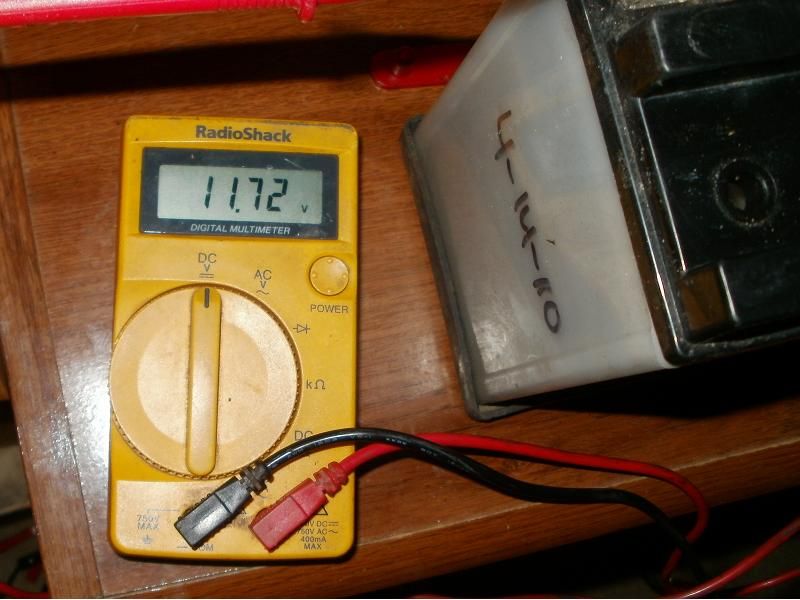
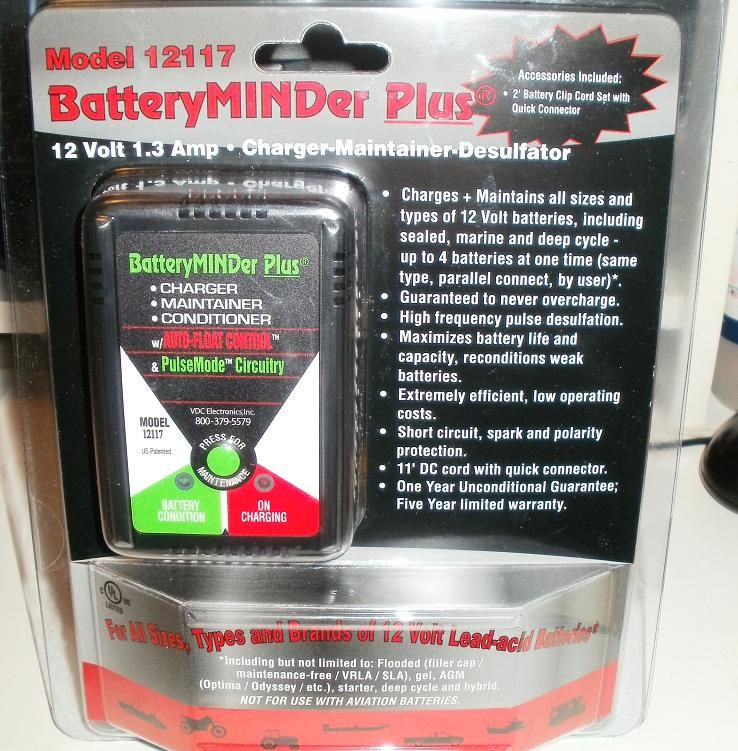
The Pulse Charger/Minder has 2 LEDs, left one just verifies that you have it connected to the battery correctly, and the right one shows that it's in Charging mode....it automatically goes into PULSE/Conditioning/Charge mode. You can select to put it in the FLOAT mode with the center button.
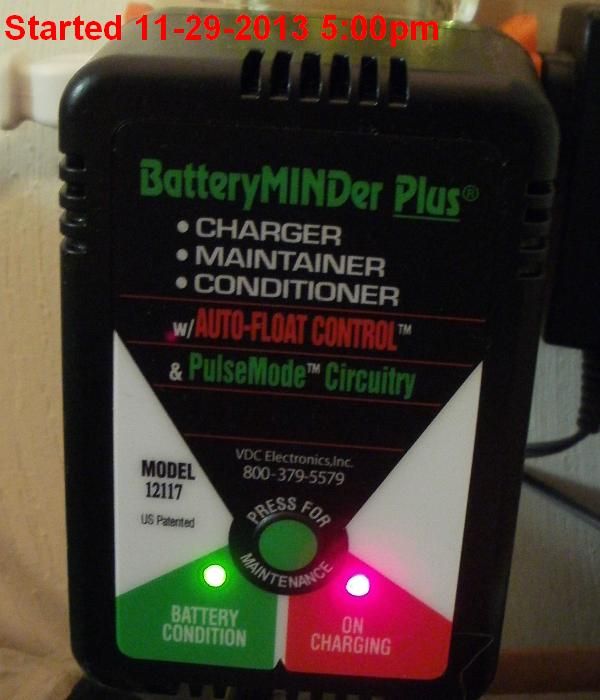
As has been mentioned it can take a few WEEKS for it to work on the sulphates and such. Some of the other research and reading I found stated that the hard crystals that have formed deep in the main base structure of the plates don't come off easily or at all with the PULSE chargers. That the plates are made with a Lead Calcium, and that there is a THIN layer of Calcium Oxide that form between the outer layer of the Paste/Plate, and that the PULSE charger works on THAT layer, and can help increase the conductivity at that level.
Their research...they built cells within glass containers so that they could see the changes that occur to the plates, as well as then examine them closely afterwards. They found that the PULSE chargers didn't do much to the hard crystals, and that they were only able to bring the batteries up about 20% of capacity once the plates are heavily sulphated !
SO....I may not be able to actually resurrect this battery to normal potential?
Automotive starter motors usually draw about 100 amps, and so with batteries that have 600+ CCA capacity allows them to survive and function for several years as they slowly SULPHATE and loose their capacity, and it's only when they(Auto sized batteries) get near or below the 100 CCA range when they finally are considered "DEAD", not strong enough to Start the engine...and this usually takes some 5 years.
Our batteries are smaller and usually only about 250 or so CCA's. I think our starters don't take as much amperage as a car starter, perhaps 50 or so. And so again with regular usage, the bike batteries slowly sulphate and loose their CCA capacity which many of us have learned/experienced to be about 3 years.
However, this loss of capacity and sulphation occurs when the batteries are not FULLY charged back up to their capacity when not in use. Once they are fully charged, the electrolyte is mostly high concentration Sulfuric Acid, and can be stored IN THE COLD just fine for quite some time. The cold slows down the self discharge rate, and the high acid level prevents freezing. It's still recommended to give the battery a TOP OFF charge once a month. The higher the acid concentration the less tendency for the battery to sulphate. When the battery is allowed to discharge...the chemical reaction that the Acid does to the lead plates, turns to lead sulphate and water, and free electrons. SO....keeping the battery as fully charged as possible converts the mild layers of lead sulphate back into LEAD and sulfuric acid, but can consume some water when the charging goes too far/overcharge...there's no more sulphate to convert, so it then turns to ELECTROLYSIS of the water and that's when it can "boil" away along with releasing hydrogen and oxygen gasses.
So....float charging does NOT damage the batteries provided it's enough current to truly keep the battery fully charged, provided it doesn't go into GASSING mode which then runs the electrolyte DRY/below the plate levels.
T.C.
Okay folks,
I know how we like photos, and I had taken a bunch several years ago when I first installed this new battery, to make a tech tip about what to do when you install a new battery, etc., but never got around to posting them.
Okay, just showing the packaging for the Walmart brand, that it comes with the battery and acid packed separately, it's "dry charged", and you get to add the acid once you get it home.

Just a warning about removing the drain hose port cover so that it can vent when you add the acid as well as charging later.

Showing a backlit view so you can see the dry cells, and the low and high water indicator lines.

Here I am adding the electrolyte, it comes with a handy little hose, I should have been wearing gloves!
 Having the backlit helps to visualize the fluid levels without having to stick your face/eyes directly OVER the battery filler holes, fumes and such!
Having the backlit helps to visualize the fluid levels without having to stick your face/eyes directly OVER the battery filler holes, fumes and such!
Next just shows the barely 12 volts reading on the voltmeter after putting in the electrolyte.

These show it first being on the 2 amp charger...and then after it's been on for some 10 or so hours after it's reached it's full charge potential. IT's highly recommended to do this BEFORE you ever put the battery into service.

And the final voltmeter reading showing a good 13 volts after the charge.

Now the same battery some 3+ years later, after it sat in the garage for 2 months and allowed to go totally FLAT, and apparently it also ran low on water. I had filled it up just prior to going on the Rally Ride in Sept.! Some of you will also remember that I'm using the Mini-Race Alternator, it does put out a lot more power than the OEM REG/RECT/ALT combo, but I've got a voltmeter on it, and it doesn't go above 14 or so volts while riding, so I don't think it's getting OVERCHARGED while riding, just that the air has been quite dry around here, and it's just slowly evaporated over the last 2 months that it's been sitting....it's NOT been on a trickle/float charger!


A couple of days prior to this, I had mentioned that I had tried to charge it with the same shown charger, first on 2 amps for a day, and then on 6 amps overnight! Then just let it sit for a day or so until I got new fancy Pulse charger...and so the voltmeter shows not quite 5 volts!


Put it on the same charger in the 6 amp mode for about an hour.

And then the voltmeter shows it got up to almost 12 volts....needed to get it up to 10.5 or more before being able to hook up the fancy PULSE charger..needs the 10.5 minimum for it to work...apparently will sense the volts and such.


The Pulse Charger/Minder has 2 LEDs, left one just verifies that you have it connected to the battery correctly, and the right one shows that it's in Charging mode....it automatically goes into PULSE/Conditioning/Charge mode. You can select to put it in the FLOAT mode with the center button.

As has been mentioned it can take a few WEEKS for it to work on the sulphates and such. Some of the other research and reading I found stated that the hard crystals that have formed deep in the main base structure of the plates don't come off easily or at all with the PULSE chargers. That the plates are made with a Lead Calcium, and that there is a THIN layer of Calcium Oxide that form between the outer layer of the Paste/Plate, and that the PULSE charger works on THAT layer, and can help increase the conductivity at that level.
Their research...they built cells within glass containers so that they could see the changes that occur to the plates, as well as then examine them closely afterwards. They found that the PULSE chargers didn't do much to the hard crystals, and that they were only able to bring the batteries up about 20% of capacity once the plates are heavily sulphated !

SO....I may not be able to actually resurrect this battery to normal potential?
Automotive starter motors usually draw about 100 amps, and so with batteries that have 600+ CCA capacity allows them to survive and function for several years as they slowly SULPHATE and loose their capacity, and it's only when they(Auto sized batteries) get near or below the 100 CCA range when they finally are considered "DEAD", not strong enough to Start the engine...and this usually takes some 5 years.
Our batteries are smaller and usually only about 250 or so CCA's. I think our starters don't take as much amperage as a car starter, perhaps 50 or so. And so again with regular usage, the bike batteries slowly sulphate and loose their CCA capacity which many of us have learned/experienced to be about 3 years.
However, this loss of capacity and sulphation occurs when the batteries are not FULLY charged back up to their capacity when not in use. Once they are fully charged, the electrolyte is mostly high concentration Sulfuric Acid, and can be stored IN THE COLD just fine for quite some time. The cold slows down the self discharge rate, and the high acid level prevents freezing. It's still recommended to give the battery a TOP OFF charge once a month. The higher the acid concentration the less tendency for the battery to sulphate. When the battery is allowed to discharge...the chemical reaction that the Acid does to the lead plates, turns to lead sulphate and water, and free electrons. SO....keeping the battery as fully charged as possible converts the mild layers of lead sulphate back into LEAD and sulfuric acid, but can consume some water when the charging goes too far/overcharge...there's no more sulphate to convert, so it then turns to ELECTROLYSIS of the water and that's when it can "boil" away along with releasing hydrogen and oxygen gasses.
So....float charging does NOT damage the batteries provided it's enough current to truly keep the battery fully charged, provided it doesn't go into GASSING mode which then runs the electrolyte DRY/below the plate levels.
T.C.
 My experience this summer was that after 3 1/2 years exactly the same time as yours my Everstart battery was no longer holding a charge for more than a few days.
My experience this summer was that after 3 1/2 years exactly the same time as yours my Everstart battery was no longer holding a charge for more than a few days.



 But it had only been 1 day, so I put it back on the Pulse Charger...it's still showing the SOLID RED charging light.. book says it will blink when it's fully charged and in FLOAT mode! Another thing is that I can see bubbles forming in all of the cells. I felt the case and it's "WARM"....not hot, I can easily hold my hands on it without any sense of needing to remove them burn feeling, so the little 1.3 amp PULSE charger is doing SOMETHING, will check it in a few days for both voltage levels and another LOAD test.
But it had only been 1 day, so I put it back on the Pulse Charger...it's still showing the SOLID RED charging light.. book says it will blink when it's fully charged and in FLOAT mode! Another thing is that I can see bubbles forming in all of the cells. I felt the case and it's "WARM"....not hot, I can easily hold my hands on it without any sense of needing to remove them burn feeling, so the little 1.3 amp PULSE charger is doing SOMETHING, will check it in a few days for both voltage levels and another LOAD test. 

Comment